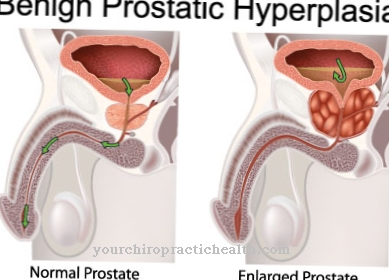In the Nodular fasciitis Nodular and fibroblastic growths form on the fascia, which correspond to benign tumors. According to speculation, these are reactive processes following trauma or inflammation of the tissue. The differentiation from malignant diseases is particularly difficult for the pathologist.
What is nodular fasciitis?

© designua - stock.adobe.com
The fasciae are soft tissue components of the connective tissue. Various malignant and benign tumors can originate from them. A benign tumor disease of the fascia is fibromatosis, which, despite its benign nature, often aggressively infiltrates the surrounding area. The Fasciitis nodularis is a disease of the fascia with fibroblastic growths of the tissue.
The expressions become synonymous nodular fasciitis, pseudosarcomatous dermatofibroma and pseudosarcomatous fibromatosis used. The pathological phenomenon is one of the fibroproliferative diseases and is one of the most common findings in this area. The exact prevalence is not yet known.
The disease occurs without gender preference and mostly affects people between the ages of 20 and 50. Diagnosis of the disease is difficult because of the histological similarity to fibromatoses and fibrosarcomas. In the past, the delimitation difficulties often resulted in wrong therapy decisions.
causes
The etiology of nodular fasciitis has not yet been conclusively clarified. For the apparently related fibromatoses of the connective tissue, the triggering cause is still unclear. Presumably, the growths of fasciitis nodularis are reactive processes. In most cases, spontaneous remission occurs. There are usually no recurrences.
Science now associates the growths with trauma. There is currently speculation about the extent to which previous injuries to the fascia could play a role in the reactive changes. Previous acts of violence or unspecific inflammation are often related to the process.
Genetic factors may also be relevant for the disease of nodular fasciitis. Since many cases of nodular fasciitis are not recognized and diagnosed as fibromatoses or related phenomena, research into the cause is difficult.
Symptoms, ailments & signs
Patients with nodular fasciitis suffer from solitary growths of more than two and a maximum of three centimeters in the subcutaneous tissue. The growths appear coarse and are easily demarcated from their surroundings. The fibroblastic nodules grow rapidly and in most cases are symptom-free. The lesions are rarely sensitive to pressure.
The growths start from the fascia tissue and mostly infiltrate the subcutaneous fat tissue. In some cases, they penetrate into the muscles. The growths are vascular and mostly consist of large, spindle-like fibroblasts or myofibroblasts. They can contain innumerable mitoses and usually have prominent protruding endothelia. Multinucleated giant cells can be contained in different densities.
The core formations usually seem bizarre. The stroma is loosely lined with myxoid and characterized by fibrous structures. The growths tend to occur on the upper extremities, especially in the forearms. The trunk area of the patient is rarely affected by the nodules.
Diagnosis & course
When diagnosing nodular fasciitis, the doctor faces a challenge. The diagnosis is based on a biopsy of the affected tissue, which is analyzed histologically. The histological differential diagnosis turns out to be difficult. The sarcoma-like findings often lead to misdiagnosis and therapeutically incorrect decisions such as radiation therapy.
Studies show that of 55 cases of nodular fasciitis, almost half were diagnosed as sarcomas. Less than a fifth of the cases were recognized as nodular fasciitis. The soft tissue lesion is known for the great difficulty it presents to the pathologist in histology. Depending on the individual case, it can be difficult for the responsible doctor to distinguish it from other diseases such as fibromatosis, fibrosarcoma and fibrous malignant histiocytoma. Patients with nodular fasciitis have a good prognosis, as the tumors usually recede spontaneously and often do not reappear.
Complications
As a rule, nodular fasciitis leads to the development of benign tumors. However, complications can arise with this disease, as benign tumors can hardly be distinguished from malignant cancers. The person affected mainly suffers from strong growths that can cover the body in different places.
The knots make most patients unattractive and therefore suffer from reduced self-esteem. This can also cause lesions that are sensitive to pain. If the growths penetrate into the muscle tissue, it can also lead to movement restrictions and severe pain. The patient's everyday life is severely restricted due to the illness.
The treatment itself is primarily carried out to differentiate the malignant tumors from the benign tumors. If malignant cancers are found, they are surgically removed. As a rule, the disease progresses positively if the tumor is treated early.
There are no complications. However, the patient has to undergo some follow-up examinations, as the nodular fasciitis can recur if the incomplete tumor tissue has been removed.
When should you go to the doctor?
Nodular fasciitis must always be examined and treated by a doctor. As a rule, the symptoms of the disease do not go away on their own, so treatment is always necessary. A doctor should then be consulted if the patient suffers from growths in the tissue or on the skin.
However, these growths are often only recognized during control examinations. Even if the nodes are not dangerous, they should still be examined. A visit to the doctor is particularly necessary if the lump is tender or painful.
The pain can also be transferred to the muscles. In the case of nodular fasciitis, the general practitioner or dermatologist is usually consulted first. Further treatment will then be carried out by another specialist and will depend heavily on the severity of the symptoms. In many cases, the patients rely on radiation therapy to relieve the symptoms.
In addition, even after successful treatment, those affected are dependent on regular examinations in order to avoid complications and other complaints. As a rule, nodular fasciitis does not reduce the patient's life expectancy.
Doctors & therapists in your area
Treatment & Therapy
Since the cause of the nodular fasciitis has not yet been definitively clarified, a causal therapy is unthinkable. Only symptomatic therapies can be used. On the other hand, the lesions tend to spontaneously remission and for this reason do not always need to be treated immediately. The differentiation from malignant tissue growths is the most important step for an appropriate therapy decision.
Patients with nodular fasciitis should under no circumstances have to undergo radiation therapy or similar therapeutic measures that are harmful to health, which are used in the event of malignant findings. Surgical excision is also usually not necessary in patients with nodular fasciitis. Close monitoring of the patient is advisable for the first few months.
Surgical steps are initially not indicated. The monitoring corresponds above all to a size control of the growths. Checking for any accompanying inflammation is also relevant during the waiting period. If the growths have not regressed on their own within a few months, surgical excision can be made. In this procedure, the growths are removed as completely as possible so that no recurrences occur.
After removal, the patient has regular check-ups to rule out recurrence. Since such a relapse occurs only extremely rarely in this disease, the therapy with the remission or excision of the lesions is usually final and complete.
Outlook & forecast
The prognosis for nodular fasciitis is favorable. The benign tumors normally do not cause any life-threatening consequences. Since no surgery is performed or a mutation is expected, no serious complications arise.The changes in the complexion can be subject to spontaneous healing at any time. In these cases the prognosis is particularly favorable.
Without treatment, however, it is more common for the growths to spread and thus an increase in symptoms. As soon as adequate medical care is obtained, the symptoms will be alleviated within a few weeks or months.
Since there is no causal treatment method for nodular fasciitis, the therapeutic methods can be oriented differently. This can lead to delays in the healing process or intolerance to the active ingredients used are conceivable. These are of a temporary nature.
Although nodular fasciitis has a favorable prognosis, it can recur at any time during life. In addition, the changes in the skin's appearance must always be distinguished from malignant processes. Control visits and clarification of the complaints are therefore necessary for every relapse. Due to the visual abnormalities, the disease can lead to emotional and mental problems. Guilt, shame and withdrawal behavior can be expected. In exceptional cases, this can cause mental illness and thus have a negative impact on the overall prognosis.
prevention
It is still unclear what the underlying cause of the nodular fasciitis is. For this reason, there are no preventive steps available.
Aftercare
With nodular fasciitis, the options for follow-up care are very limited. First and foremost, the symptoms must be treated directly and medically in order to prevent further complications and inflammation of the tissue. Self-healing cannot occur, and early diagnosis and treatment of nodular fasciitis always have a positive effect on the further course of the disease.
Whether this will result in a reduced life expectancy cannot generally be predicted. The nodular fasciitis should always be examined and monitored by a doctor in order to rule out any malignancy of the growth. Regular examinations by a doctor are necessary.
In the event of a malignant growth, it must be removed by surgery. As a rule, the person affected should always rest and take it easy after such an operation. Above all, the affected area should be spared so that there is no new nodular fasciitis.
Since nodular fasciitis can recur, an examination must be performed even after successful treatment. In the case of this disease, contact with other affected persons can also be useful, as this often leads to an exchange of information.
You can do that yourself
Patients with nodular fasciitis have few opportunities to help themselves. Since in most cases the disease is largely symptom-free, there are also few physical impairments.
If there is a diagnosis, strengthening of the mental strength is often required. This can be achieved with sufficient rest periods and sufficient rest. Participation in relaxation procedures is recommended, as this can reduce stress that builds up in everyday life. Techniques such as yoga or meditation improve wellbeing, which in principle has a positive influence on health.
If the nodular fasciitis causes growths, it should be avoided to scratch or rub the affected areas. If open wounds develop, pathogens can enter the organism and trigger further diseases. In severe cases there is a risk of blood poisoning, which can be avoided with a little discipline in advance.
If muscle problems arise, it is helpful if the patient avoids overexertion and excessive physical exertion. A sufficient supply of heat is helpful to support the muscles. In addition, there should be a healthy eating plan and sufficient fluids should be consumed during the day. Unilateral movements or poor posture of the body should be avoided as far as possible despite existing muscular problems.
























.jpg)



